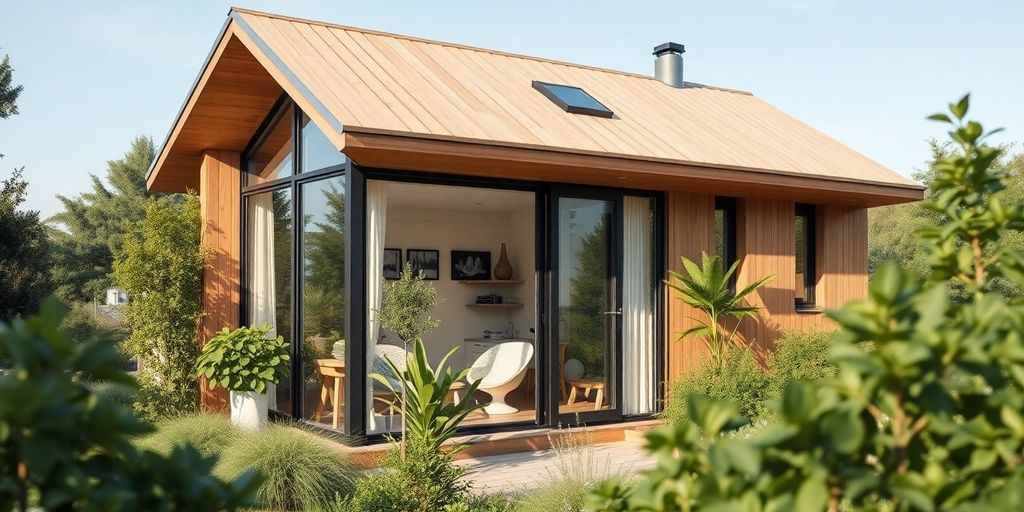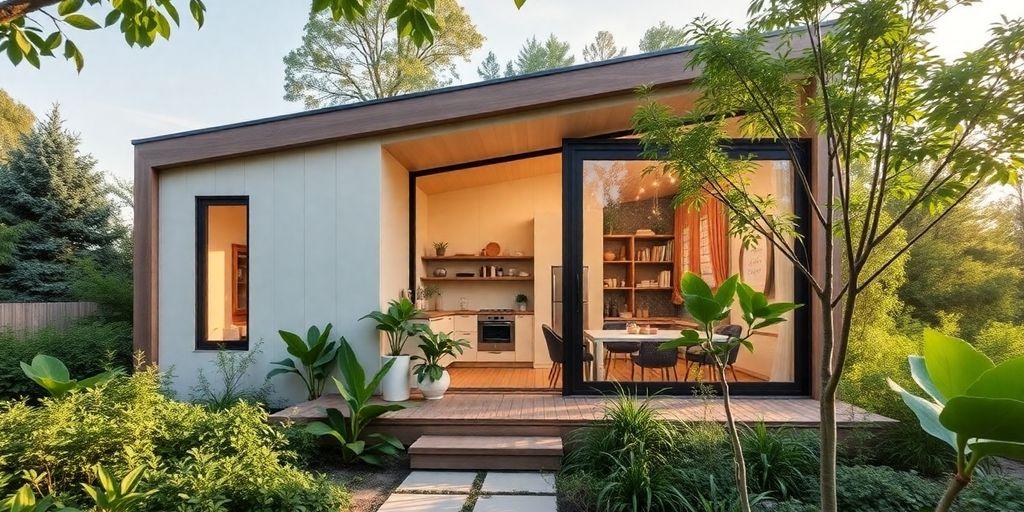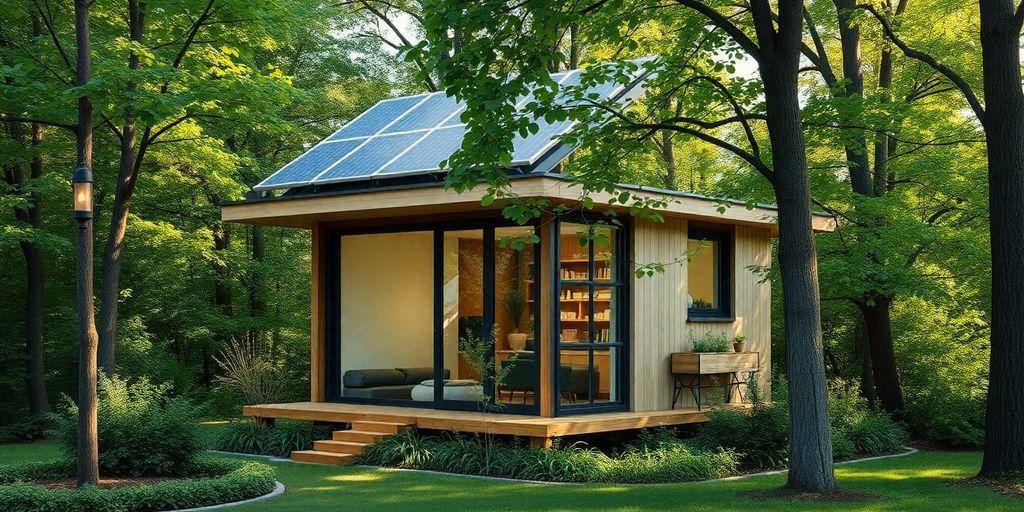
In recent years, the housing landscape has shifted dramatically, with a growing emphasis on smaller, smarter homes. These homes not only provide a solution to rising costs but also embrace technology and sustainability. This article explores how smart home design is shaping the future of housing, particularly through the innovative work of Tinee Homes. We’ll delve into the benefits of smaller homes, the importance of eco-friendly practises, and the exciting construction methods that are paving the way for a new era of living.
Key Takeaways
- Smart home design incorporates technology for enhanced living experiences.
- Smaller homes promote affordability and minimalism, appealing to a wide range of people.
- Sustainable building practises are becoming standard in modern home construction.
- Innovative construction methods like modular building are speeding up the housing process.
- Tinee Homes showcases successful projects that exemplify the future of housing.
Understanding Smart Home Design
Defining Smart Home Design
So, what exactly issmart home design? It’s more than just throwing a few gadgets into your house. It’s about integrating technology to create a living space that’s more convenient, efficient, and secure. Think of it as your home working for you, anticipating your needs and simplifying daily tasks. It’s about creating a cohesive system where different devices communicate with each other to enhance your lifestyle.
Key Features of Smart Homes
Smart homes come packed with features, but here are a few key ones you’ll often find:
- Automated Lighting: Control your lights from anywhere, set schedules, or even have them adjust automatically based on the time of day.
- Smart Security Systems: Monitor your home with cameras, motion sensors, and smart locks, all accessible from your smartphone. Get alerts for unusual activity and control access remotely.
- Energy Management: Smart thermostats and appliances can help you optimise energy consumption, saving you money and reducing your carbon footprint. You can track your energy usage and make adjustments to reduce your energy footprint.
- Voice Control: Integrate voice assistants like Google Assistant or Amazon Alexa to control various aspects of your home with simple voice commands.
Benefits of Smart Home Technology
Smart home technology offers a range of benefits that can significantly improve your quality of life. Here are just a few:
- Increased Convenience: Automate tasks like turning on lights, adjusting the temperature, or locking doors, freeing up your time and energy.
- Enhanced Security: Monitor your home remotely and receive alerts for any suspicious activity, providing peace of mind whether you’re at home or away.
- Improved Energy Efficiency: Smart devices can help you optimise energy consumption, reducing your utility bills and minimising your environmental impact.
- Greater Accessibility: Smart home technology can make it easier for people with disabilities or mobility issues to control their environment and live more independently.
Smart home design isn’t just about fancy gadgets; it’s about creating a living space that adapts to your needs and enhances your lifestyle. It’s about making your home work smarter, not harder.
The Rise of Smaller Homes
It’s interesting to see how housing trends are changing, isn’t it? More and more Aussies are considering smaller homes. What’s driving this shift? Well, a few things, really. People are re-evaluating what they need in a home, and often, bigger isn’t necessarily better. Let’s explore this further.
Trends in Tiny House Living
Tiny house living isn’t just a fad; it’s a lifestyle choice gaining serious traction. What exactly is a tiny house? Generally, it’s a dwelling under 400 square feet – think compact and clever. The appeal lies in simplicity and sustainability. You’re seeing more and more of these energy-efficient small homes pop up, especially among younger generations and those looking to downsize significantly. They offer a chance to escape the mortgage trap and live more intentionally. Plus, they’re often mobile, giving you the freedom to explore.
Benefits of Downsizing
Why are people choosing to live in smaller spaces? The benefits are pretty compelling:
- Reduced Costs: Smaller homes mean smaller mortgages or rent, lower utility bills, and less to maintain. This frees up cash for experiences and investments.
- Environmental Impact: Less space means less energy consumption and fewer resources used in construction and upkeep. It’s a more sustainable way to live.
- Simpler Lifestyle: Downsizing encourages you to declutter and focus on what truly matters. It’s about quality over quantity.
Living with less stuff can be incredibly liberating. It forces you to be mindful of your consumption and appreciate what you already have. It’s a shift in mindset that can positively impact all areas of your life.
Cultural Shifts Towards Minimalism
There’s a growing movement towards minimalism, and it’s influencing how we think about housing. People are questioning the need for large, sprawling homes filled with stuff they don’t really need. This shift is driven by a desire for greater financial freedom, reduced stress, and a more sustainable lifestyle. What are the benefits of tiny and modular homes? Well, they perfectly align with these values, offering a practical and stylish way to embrace a minimalist lifestyle. You’re seeing this reflected in the popularity of shows about tiny homes and the increasing availability of small homes WA.

Sustainability in Housing
Eco-Friendly Building Materials
Choosing the right materials is a big deal when it comes to sustainable housing. We’re talking about stuff that doesn’t harm the environment, is durable, and ideally, locally sourced. Think about materials like recycled timber, bamboo, or even hempcrete. These options reduce the carbon footprint of your home and can even improve indoor air quality. It’s about making smart choices from the ground up.
Energy Efficiency in Smart Homes
Smart homes aren’t just about fancy gadgets; they can seriously cut down on energy use. Smart thermostats, lighting systems, and appliances can all be programmed to optimise energy consumption. For example, automated blinds can adjust to the sun’s position, reducing the need for air conditioning. It’s about using technology to live more efficiently and reduce your environmental impact. What are the benefits of container houses?
The Role of Renewable Energy
Renewable energy is a game-changer for sustainable housing. Solar panels are the most obvious example, but wind turbines and geothermal systems are also options. By generating your own power, you can reduce your reliance on the grid and lower your carbon footprint. Plus, with government incentives and falling prices, renewable energy is becoming more accessible than ever. This is a key part of what is the future of affordable housing.
Integrating renewable energy sources into your home design not only reduces your environmental impact but also offers long-term cost savings. It’s a win-win for both your wallet and the planet.
Here’s a quick look at some renewable energy options:
- Solar Panels: Convert sunlight into electricity.
- Wind Turbines: Generate power from wind energy.
- Geothermal Systems: Use the Earth’s natural heat for heating and cooling.
And here’s a table showing potential savings:
Renewable Energy Source | Average Annual Savings |
Solar Panels | $1,000 – $2,000 |
Wind Turbine | $500 – $1,500 |
Geothermal System | $800 – $2,500 |
Innovative Construction Methods
The way we build houses is changing, and it’s about time! For too long, the construction industry has been stuck in its ways, but now, with new technologies and a growing need for affordable and sustainable housing, things are finally starting to shift. Let’s take a look at some of the exciting innovations that are shaping the future of home building.
Modular and Prefabricated Homes
Modular and prefabricated homes are gaining serious traction, and for good reason. Instead of building a house from scratch on-site, these homes are constructed in sections in a factory. These sections, or modules, are then transported to the building site and assembled. This approach offers a bunch of advantages, including faster construction times and reduced costs.
- They can be completed in weeks, not months.
- There’s less waste involved.
- They can be more energy-efficient than traditional builds.
Companies like Modscape and Archiblox are leading the charge in Australia, offering stylish and affordable modular options. If you’re wondering about modular construction and how it can speed up the building process, it’s definitely worth a look.
3D Printing in Home Building
3D printing might sound like something out of a sci-fi movie, but it’s becoming a reality in the construction world. This technology uses large machines to “print” layers of material, like concrete, to create walls and structures. It’s incredibly fast and can significantly reduce labour costs. Imagine printing a house in just a few days! While it’s still early days, the potential is huge. There’s even a 3D-printed home in Melbourne showcasing what’s possible. How does 3D printing reduce labour costs? Well, it automates a lot of the manual work, meaning fewer tradies are needed on site.
Rapid Construction Techniques
We need to build houses faster, and rapid construction techniques are the answer. These methods aim to speed up the building process without compromising quality. This can involve using innovative materials, streamlining the construction process, and adopting new technologies. The goal is to get homes built quickly and efficiently, addressing the growing demand for housing. What are some examples of rapid construction? Think precast concrete, panelised systems, and other methods that allow for faster assembly on site. These techniques are essential for tackling housing shortages and making homes more accessible.
Customisation and Personalisation
Smart homes aren’t just about fancy gadgets; they’re about creating a space that truly reflects you. It’s about tailoring your living environment to suit your specific needs and preferences. How can you make a smart home truly yours? Let’s explore.
Tailoring Smart Home Features
Think of your smart home as a blank canvas. You get to choose the colours, the textures, and the overall vibe. With smart home tech, it’s the same. Want your lights to dim automatically at sunset? Easy. Prefer your coffee to start brewing as soon as your alarm goes off? Done. The possibilities are pretty much endless. It’s all about finding the features that genuinely make your life easier and more enjoyable. What smart features are most important to you?
Designing for Individual Needs
One of the biggest advantages of smart homes is their ability to adapt to individual needs. This is especially important for people with disabilities or those who are ageing. Smart home technology can provide increased independence and safety. For example, voice-controlled systems can help people who have mobility issues, and smart sensors can alert caregivers to potential falls. It’s about creating a home that supports everyone who lives there, regardless of their abilities.
The Importance of User Experience
Let’s be real, no one wants a home that’s frustrating to use. That’s why user experience (UX) is so important in smart home design. It’s not enough to have all the latest gadgets; they need to be easy to control and integrate seamlessly into your daily life. A good UX means intuitive interfaces, simple setup processes, and reliable performance. If your smart home is a pain to use, you’re not going to use it. It’s that simple.
A well-designed smart home should feel like a natural extension of yourself. It should anticipate your needs and make your life easier, without requiring you to constantly fiddle with complicated settings.
Here are some things to consider when thinking about user experience:
- Simplicity: Is the system easy to understand and use?
- Reliability: Does the technology work consistently?
- Integration: Do all the devices work well together?
Cost-Effectiveness of Smart Homes
Comparing Traditional vs. Smart Homes
Okay, let’s get real about money. When you’re looking at a traditional home versus a smart home, the upfront costs can look pretty different. Traditional homes, well, we know what to expect. But smart homes? They come with integrated technology that can bump up that initial price tag. But don’t freak out just yet! It’s like buying a car – you can get a basic model or one loaded with all the fancy features. Smart homes are the same; you can start small and add more tech later. The big question is, what are you actually paying for, and is it worth it?
Long-Term Savings on Utilities
This is where smart homes really shine, mate. Think about it: smart thermostats that learn your habits and adjust the temperature automatically, lighting systems that dim when you’re not around, and appliances that use way less energy. All these things add up over time. You could be looking at some serious savings on your electricity and water bills.
Here’s a quick look at potential savings:
Feature | Traditional Home | Smart Home | Potential Savings |
Thermostat | Manual | Smart | 10-20% |
Lighting | Standard Bulbs | LED & Smart | 20-30% |
Water Usage | Standard | Smart | 15-25% |
It’s not just about saving money, though. It’s about being smarter with our resources and reducing our environmental footprint. That’s a win-win in my book.
Plus, smart homes can often detect leaks or other problems early, saving you from costly repairs down the line. So, while the initial investment might be higher, the long-term savings can definitely make it worthwhile. You can also look into multifunctional furniture to save space and money.
Financing Options for Smart Homes
Alright, so you’re sold on the idea of a smart home, but you’re wondering how to pay for it? Good question! There are actually a few different ways to finance a smart home.
- Green Loans: Some banks offer special loans for eco-friendly upgrades, which can include smart home technology.
- Mortgage Add-ons: You might be able to add the cost of smart home features to your mortgage when you’re buying or refinancing.
- Government Rebates: Keep an eye out for government rebates or incentives for energy-efficient upgrades. These can help offset the cost of installing smart home tech.
Don’t be afraid to shop around and compare different options. And remember, investing in a smart home isn’t just about the gadgets; it’s about investing in a more sustainable and cost-effective future. It’s about asking yourself,

Showcasing Tinee Homes Projects
Recent Developments by Tinee Homes
At Tinee Homes, we’re always pushing the boundaries of what’s possible in the world of small-space living. We’ve been busy bees, working on some exciting new projects that showcase our commitment to innovation, sustainability, and customisation. One of our latest developments is the ‘Urban Oasis’ project, a series of modular homes designed for compact city living. These homes feature integrated smart technology and eco-friendly materials, making them both comfortable and sustainable. Another exciting project is our ‘Coastal Retreat’ series, designed for those seeking a minimalist lifestyle by the sea. These homes are built to withstand the harsh coastal environment while providing a luxurious and relaxing living space. We’re also exploring new construction methods, such as 3D printing, to create affordable and sustainable housing solutions for everyone. What kind of innovative designs are we working on?
Client Testimonials and Success Stories
Nothing speaks louder than the experiences of our satisfied clients. We’re incredibly proud of the positive feedback we’ve received from people who have embraced the Tinee Homes lifestyle. Many clients rave about the cost savings they’ve achieved through reduced energy consumption and lower mortgage payments. Here are a few snippets:
- “I never thought I could live so comfortably in such a small space. Tinee Homes made the whole process so easy and stress-free!” – Sarah M.
- “The smart home features have made my life so much easier. I can control everything from my phone, and I’m saving a fortune on my energy bills.” – David L.
- “The quality of the construction is outstanding. I feel safe and secure in my Tinee Home, even during the wildest storms.” – Emily B.
Choosing Tinee Homes was the best decision I ever made. I’m living a more sustainable and fulfilling life, and I couldn’t be happier.
Innovative Designs in Action
Our designs aren’t just concepts; they’re real, functional homes that are changing the way people live. We believe that small homes can be just as stylish and comfortable as traditional houses, and our projects are proof of that. Take our ‘Skyline’ project, for example. This home features a rooftop garden and panoramic views of the city, making it the perfect urban retreat. Or consider our ‘Outback Oasis’, a self-sufficient off-grid home designed for remote living. This home is powered by solar energy and features a rainwater harvesting system, allowing residents to live completely independently. We’re also experimenting with new materials and technologies to create even more sustainable and affordable homes in the future. What are the recent developments in tiny homes?
At Tinee Homes, we take pride in our unique projects that showcase the beauty and functionality of tiny living. Each home is designed with care, ensuring that every detail meets our high standards. If you’re curious to see more of our work or want to start your own tiny home journey, visit our website today!
Wrapping Up: The Shift Towards Smaller, Smarter Living
In conclusion, the rise of smaller homes like those from Tinee Homes is more than just a trend; it’s a response to the changing needs of our society. With a focus on sustainability, tech integration, and customisation, these homes offer a practical solution to the housing crisis. They not only save costs but also promote a simpler, more efficient lifestyle. As we look to the future, it’s clear that smaller, smarter homes are paving the way for a more affordable and sustainable living environment for everyone. Embracing this shift could lead to a brighter, more inclusive housing landscape.
Frequently Asked Questions
What is smart home design?
Smart home design means using technology to make homes easier and more efficient. This can include things like smart lights, locks, and heating systems that can be controlled from your phone.
Why are smaller homes becoming popular?
Smaller homes, like tiny houses, are becoming popular because they are cheaper to buy and maintain. They also fit well with the trend of living simply and focusing on what really matters.
How do smart homes save energy?
Smart homes use energy-efficient devices and systems that can adjust usage based on your needs. For example, smart thermostats can learn your schedule and save energy when you’re not home.
What are some new ways to build homes?
New building methods include modular homes that are made in sections and put together on-site, and 3D printing which can create home parts quickly and cheaply.
Can I customise my smart home?
Yes! Smart homes can be tailored to fit your needs. You can choose what technology you want to include and how you want your space to look.
Are smart homes more expensive?
While smart homes can have higher upfront costs, they often save money in the long run through lower utility bills and less maintenance.
